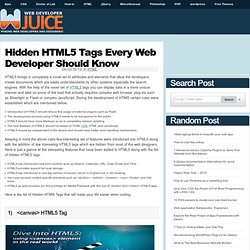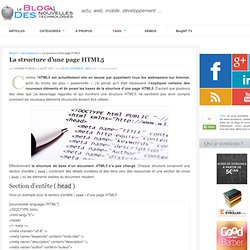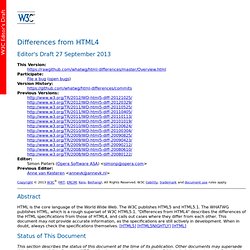

Liste des balises HTML5 - Aide mémoire et liens vers le W3C. Hidden HTML5 Tags Every Web Developer Should Know. HTML5 brings in completely a novel set of attributes and elements that allow the developers create documents which are easily understandable by other systems especially the search engines.

With the help of the novel set of HTML5 tags you can display data in a more unique manner and take on some of the load that actually requires complex web browser plug-ins such as Silverlight or Flash or complex JavaScript. During the development of HTMl5 certain rules were established which are mentioned below: Introduction of HTML5 should reduce the usage of external plugins such as Flash.The development process using HTML5 needs to be transparent to the public.HTML5 should have more Markups so as to completely replace scripting.The new features of HTML5 should be based on DOM, CSS, HTML and JavaScript.HTML5 should be independent of the device and should have better error handling mechanisms.
Here is the list of Hidden HTMl5 Tags that will make your life easier when coding: Attributs globaux hidden, contenteditable, contextmenu, spellcheck. 4.4 Sections. 4.3 Sections 4.3.1 The body element Categories: Sectioning root.

Contexts in which this element can be used: As the second element in an html element. Content model: Flow content. Tag omission in text/html: A body element's start tag can be omitted if the element is empty, or if the first thing inside the body element is not a space character or a comment, except if the first thing inside the body element is a meta, link, script, style, or template element. A body element's end tag can be omitted if the body element is not immediately followed by a comment. Content attributes: Global attributes onafterprint onbeforeprint onbeforeunload onhashchange onlanguagechange onmessage onoffline ononline onpagehide onpageshow onpopstate. HTML 5 Tags. La structure d’une page HTML5. Comme l’HTML5 est actuellement mis en œuvre par quasiment tous les webmasters sur Internet, enfin du moins les plus « passionnés », j’ai pensé qu’il était nécessaire d’expliquer certains des nouveaux éléments et de poser les bases de la structure d’une page HTML5.

D’autant que plusieurs des sites que j’ai davantage regardés et qui montrent une structure HTML5, ne semblent pas avoir compris comment les nouveaux éléments structurels doivent être utilisés. Effectivement la structure de base d’un document HTML5 n’a pas changé. Chaque structure comprend une section d’entête (head) contenant des détails invisibles et des liens vers des ressources et une section de corps (body) où les éléments visibles du document résident.
Voici un exemple pour la section d’entête (head) d’une page HTML5 : [sourcecode language="HTML"] <title>Titre de la page</title> </head> [/sourcecode] DOCTYPE (doctype) HTML5 differences from HTML4. Abstract HTML is the core language of the World Wide Web.

The W3C publishes HTML5 and HTML5.1. The WHATWG publishes HTML, which is a rough superset of W3C HTML5.1. "Differences from HTML4" describes the differences of the HTML specifications from those of HTML4, and calls out cases where they differ from each other. This document may not provide accurate information, as the specifications are still actively in development. Status of This Document This section describes the status of this document at the time of its publication. This is the 27 September 2013 Editor's Draft produced by the HTML Working Group, part of the HTML Activity. Publication as a Working Draft does not imply endorsement by the W3C Membership. This document was produced by a group operating under the 5 February 2004 W3C Patent Policy. Table of Contents 1 Introduction.
HTML5 Rocks - A resource for open web HTML5 developers. Article Archive. Element Index. <header> <h4><a href="#comment-2" rel="bookmark">Comment #2</a> by <a href=" Osborne</a></h4> <time datetime="2007-08-29T13:58Z">August 29th, 2007 at 13:58</time> </header> <p>Pellentesque habitant morbi tristique senectus et netus et malesuada fames ac turpis egestas.

Vestibulum tortor quam, feugiat vitae, ultricies eget, tempor sit amet, ante. Donec eu libero sit amet quam egestas semper. Aenean ultricies mi vitae est. Mauris placerat eleifend leo.